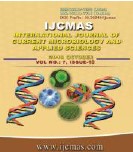


 National Academy of Agricultural Sciences (NAAS)
National Academy of Agricultural Sciences (NAAS)

|
PRINT ISSN : 2319-7692
Online ISSN : 2319-7706 Issues : 12 per year Publisher : Excellent Publishers Email : editorijcmas@gmail.com / submit@ijcmas.com Editor-in-chief: Dr.M.Prakash Index Copernicus ICV 2018: 95.39 NAAS RATING 2020: 5.38 |
The microbial pollution caused by human activities exposes urban areas of the Comoe River to major health risks linked to any pathogens presence. This study aims to assess microbiological water quality using fecal indicators bacteria (FIB) in order to determine potential risk for the populations and understand FIBs’ seasonal variability. From February 2015 to December 2016, 5 sampling campaigns were performed at 8 stations in the river (6) and tributaries (2). FIB abundances ranged between 1.09 × 103 and 8.88 × 104 E. coli (100 ml)-1 and between 5.33 × 102 and 4.49 × 103 IE (100 ml)-1 in river. They varied between 1.06 × 103 and 1.58 × 103 E. coli (100 ml)-1 and between 5.00 × 102 and 7.09 × 102 IE (100 ml)-1 in the tributaries. Based on the FIB abundance, the river presents a poor microbiological water quality for recreational and domestic activities. The concentrations observed in the river water are affected by climatic seasons with most important concentration observed during dry season. Dilution effect from tributaries waters may explain this variability. A monitoring program must be implemented to control water quality during the seasons.
 |
 |
 |
 |
 |